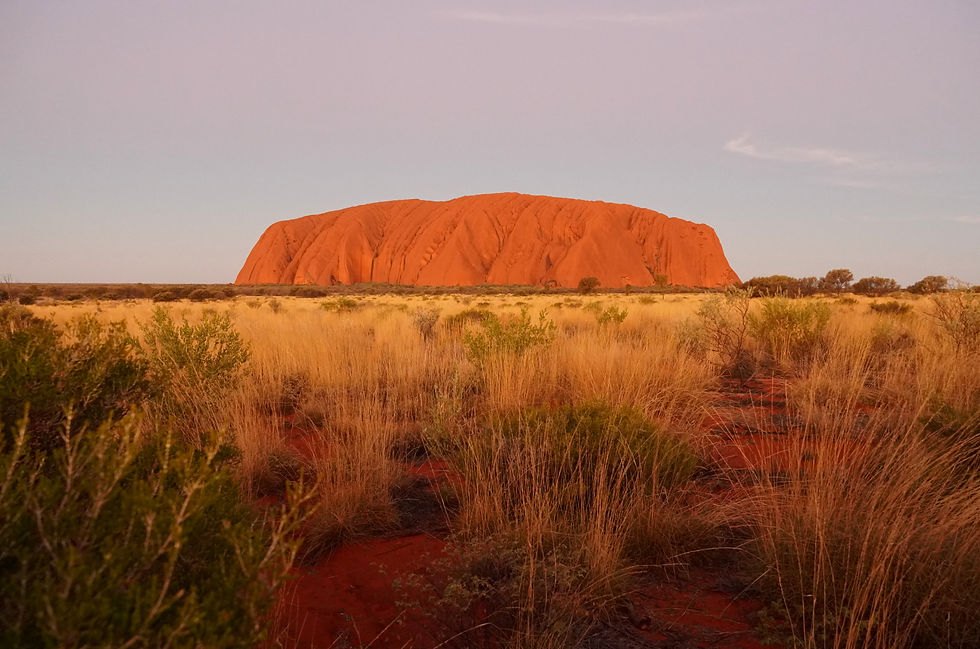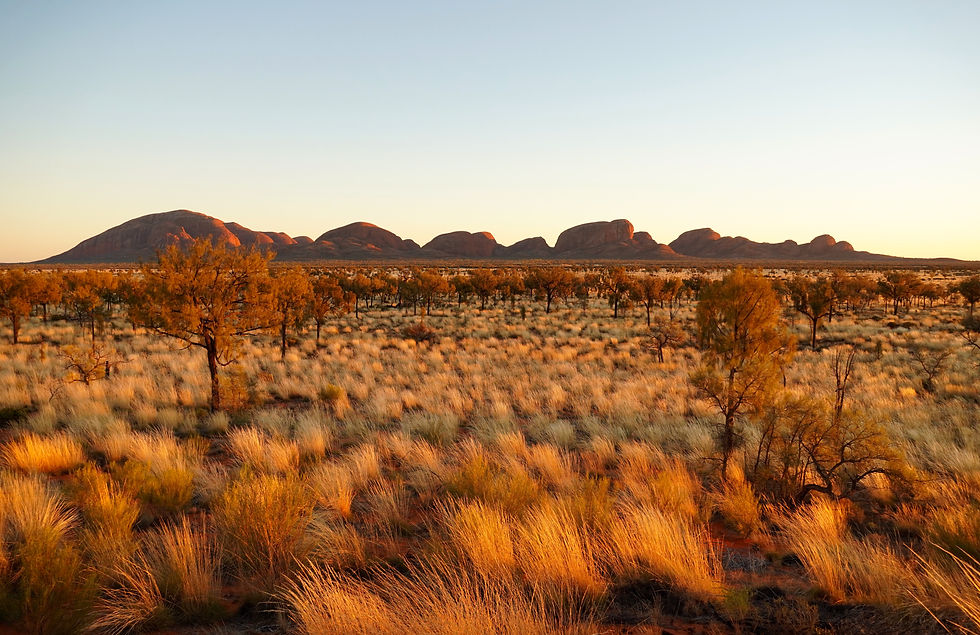Timeless Resilience: How Indigenous Presence Creates Resilience
- Nathan Burns

- Jul 24
- 6 min read
Updated: Aug 26
Uluru, Australia's most recognisable natural feature, is justifiably on most travelers' lifetime bucket lists. However, this place offers much more than just pretty memories and happy snaps—if you're willing to listen.
By Nathan Burns.
Standing in the shadow of Uluru, it’s easy to be awed by its sheer physical presence
—the way the rock glows crimson at sunset, the sheer scale of the monolith against surrounding plains, its ancient curves holding stories older than time. It is a powerful presence, at once intimidating and awe-inspiring, yet caring and encompassing, in a semi-maternal way.

For the Anangu, the Traditional Custodians of this land, Uluru is far more than a breathtaking landmark; it is a living classroom, a keeper of wisdom, a place of rest, peace, happiness and a testament to a way of life that has sustained people and Country for tens of thousands of years. In some ways, it is a physical symbol of Tjukurpa (pronounced "chook-orr-pa"), the ancient ancestral law and belief system that governs Anangu culture and understanding.
Sadly, for most modern visitors the true power of this place passes by somewhat unnoticed. For—if nothing else, in this day and age— Uluru represents a struggle between many competing interests: tradition vs. modernity, wisdom vs. shallow understanding, deep experience vs. bucket-list ticks. A happy-snap here, a trot around the base, then it’s back to air-conditioned comfort and cold beverages, priced well-beyond the means of most traditional residents.
As a travelling family, we have been acutely aware of the fact that–if we’re not

careful– falling into this trap could be all too easy. So, it was with real intent and purpose that our family approached this place. In the week leading up to entering the Uluru Kata Tjuta National Park, we embarked on a process of discovery and education– explaining the antiquity of this country to our 8 year-old daughter and devouring pre-reading about lore, geology and custom. Within the park, we spent countless hours (across five full days) with eyes wide-open and ears finely-tuned, attempting as best we could to squeeze every morsel of knowledge from our surroundings. We walked, sat, rode, listened, talked, inspected, questioned, read, drew and photographed (where appropriate) the area at most times of day, with open minds and genuinely inquisitive hearts.
In essence, we wanted to try to understand, not just visit.
And so it was, along with a few other like-minded travellers, that we found ourselves listening to James, one of the Indigenous Park Rangers, as he led us through the many details surrounding the use, symbolism and importance of Uluru. It was a fascinating morning (free, by-the-way, and highly recommended), laced with humour, mysticism and intelligent discussion.
Towards the end of our walk, as I sidled up to James to pepper him with questions, I overheard the tail of a conversation that would lead me down a path of contemplation, of which I am positive there is no end.
“How did the ancient people survive so long out…here?”, asked a middle aged German lady as she waved her hands across the seemingly desolate landscape.
“Well, the thing is”, said James, gently stroking his long beard in contemplation, “Our

people weren’t surviving. They were living and learning in every way, in every moment, for thousands of years."
“And every part of this knowledge was passed on, in some way. They didn’t really worry about the future, and the past was an immense source of knowledge and support. They were so resilient and they could learn so much, I guess, because they lived entirely in the present”.
Of course, it was this last sentence that piqued my interest and began my incessant ruminations. Does this simple statement hold the key to Resilience that modern systems are only just beginning to understand? How important is learning as a component of Resilience? Is worry and stress the thief of knowledge? How can living more presently aid Resilience? What can we learn from a culture that has not just survived - but thrived - in this harsh land?
With my mind whirring, I whittled away at ideas until I came upon a simple hypothesis: knowledge is a fundamental cornerstone of Resilience. Not just knowledge (ie; not just being “smart/wise/capable”), but the continual acquisition of knowledge over lifetimes, generations and epochs. Which inherently points to an omnipresent ability to learn and keep learning.
Granted, this probably isn’t a revelation that will win the Nobel Prize for Science, however in the deep shadows of Uluru, leaning back against that powerful rock, it hit like a tonne of bricks. It presented a realisation so blatantly clear: our Indigenous forebears knew more about recognising, accumulating and delivering continually knowledge than we could ever hope to know. They were - and, likely, still are - quite simply some of the greatest learners to ever roam the earth.
In accordance with with my over-working, “modern” mind, however, it also posed another befuddling question: Given the hyper-aroused, forward-thinking, stressed state
most of us live in, do we even have the capacity to learn like this anymore? Have the trappings of our futuristic lives taken away the malleability of our minds? And, importantly, is there a physiological basis for this?
My philosophical questions, I knew, would likely be with me forever more, however I had faith that there is a true physiological underpinning dictating the role of stress in learning. So, as I often do, I turned to science for answers.
Actually, that’s not entirely true. Initially, I turned to my great friend, colleague and

TRL Co-Director, Joe Knight, a man who - in my eyes - has an unquenchable thirst for knowledge.
We chatted for some time about my experience, how my ‘hypothesis’ sits against the tenets of Resilience, what we’ve learned anecdotally as Instructors and Health Professionals (spoiler alert: we know absolutely that when we put our students under acute stress, all learning stops), and how we think the science really works.
At the end of our discussion– as all great discussions should– I was left with more questions than answers and went delving into the literature.
What I found, in the end, was relatively ‘simple’ physiology and (quite honestly) something we already knew after instructing thousands of students over the years.
So here it is: Modern neuroscience reveals that acute stress triggers a biological trade-off: as cortisol floods the brain, neural activity shifts from the prefrontal cortex (responsible for higher-order learning and decision-making) to the limbic system (our primal survival circuitry).
When cortisol combines with adrenaline and glucagon—a hormonal triad that amplifies the stress response—the central nervous system effectively prioritises immediate survival over long-term adaptation. *

This explains why chronic stress impairs cognitive flexibility, memory, and creative
problem-solving. Simply put: the brain becomes locked in reactive mode, unable to access the very faculties needed to navigate complexities, such as learning.
At The Resilience Lab, we teach this under the heading “Control or BE Controlled”, whereby our body’s stress response system remains in constant hyper-arousal, if unregulated. It starts with the Sympathetic-Adreno-Medullar (SAM) system designed for fast responses, before the Hypothalamic-Pituitary-Adrenal (HPA) axis kicks in for slower, more sustained stress responses.
And – perhaps sadly– this is something that we “modern humans” know all too well. Parents, small business owners, teachers, high-consequence professionals, worried siblings, caring kids, fretful teenagers, bus drivers, Resilience Instructors….we ALL do it!
Something kicks off the cycle (an argument, an aggressive driver, a screaming kid), we ruminate and worry and feed the stress, perpetuating it over weeks, months, years...until BOOM!...off blows the lid and we quit, leave, get sick, alienate, withdraw or any myriad of other responses.
No wonder we’re struggling to be Resilient! How could we possibly learn from our surroundings and improve inherent knowledge with this fog of hormones and stimulation clouding every day?
Modern science now echoes what Indigenous cultures have always known: stress hijacks our capacity to learn, while presence restores it.
Therefore, as sentient humans, we are offered a moment-to-moment choice—to skim the surface, fret about the future or to pause, listen, and let our environment recalibrate our relationship with time, stress, and learning.
Powerful places such as Uluru invite us to shed the frantic pace of modern life (if only for a moment) and rediscover what it means to truly live in a way that nourishes resilience—not just for ourselves, but for the generations to come.

____________
Ready to build yours? Visit www.theresiliencelab.com.au and start laying foundations that won’t wash away when the storms come!!





Comments